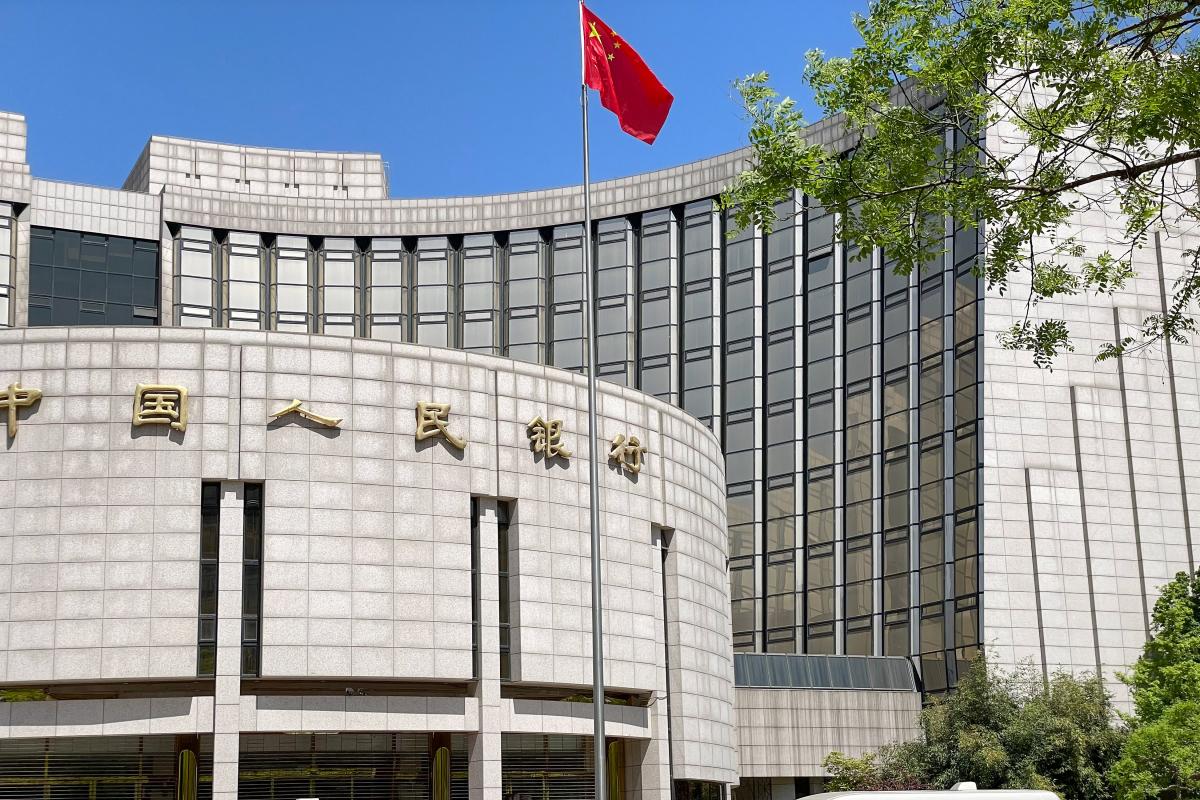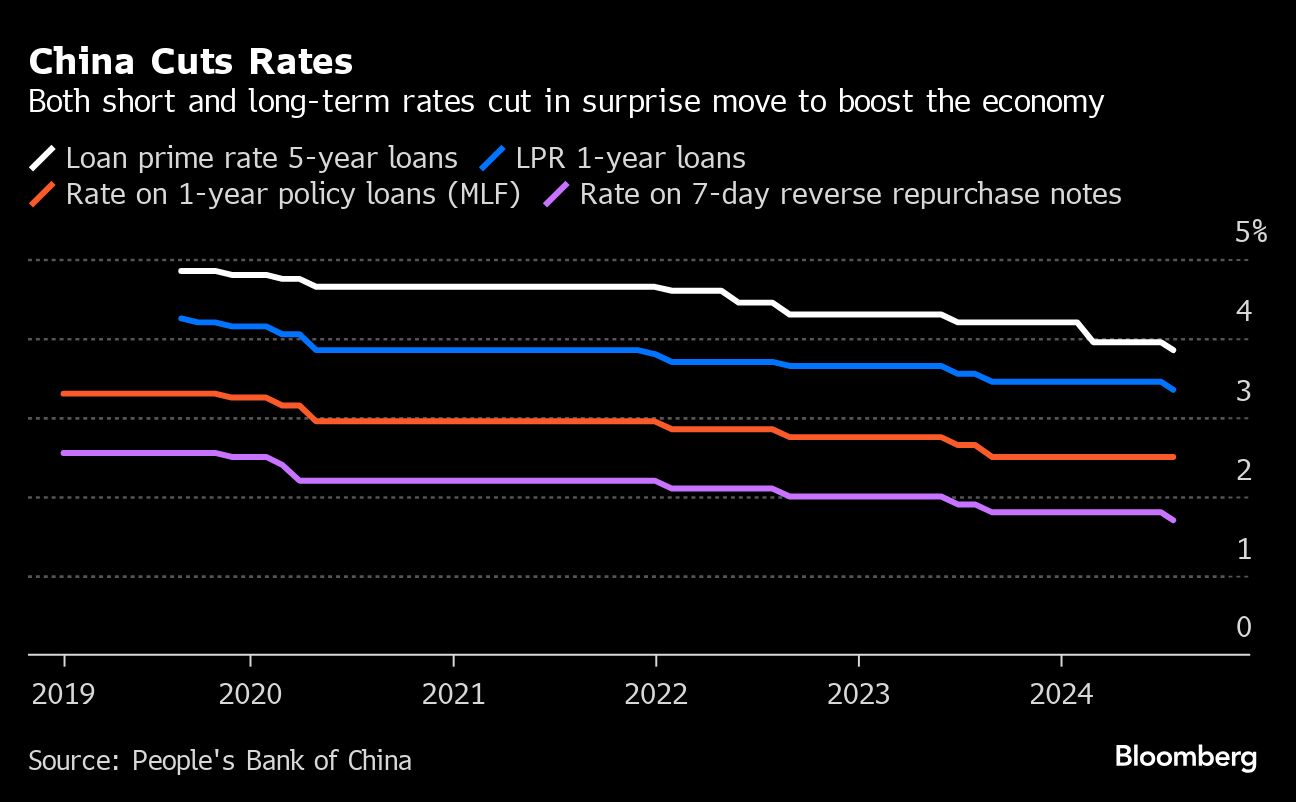China Surprises With Rate Cut After Big Meeting Disappointment
edgeinvest
Publish date: Tue, 23 Jul 2024, 09:32 AM

(July 22): China increased support for the economy with surprise interest-rate cuts, seeking to prop up growth after a lack of short-term stimulus from a major Communist Party meeting disappointed investors.
The People’s Bank of China (PBOC) on Monday cut the seven-day reverse repo rate, a key short-term policy rate, in the first reduction in almost a year. Chinese banks followed the move about an hour later by lowering their main benchmark lending rates, making it less costly to borrow for mortgages and other loans.
While modest, the concerted moves underlined authorities’ urgency to bolster an economy growing at the slowest pace in more than a year. They come just a day after the party published a sweeping document upholding President Xi Jinping’s plan to put technology at the centre of China’s economic future while tolerating slower growth in the near term.
“It’s a good sign that the government is trying to support the economy, though the fundamental impact is likely to be limited,” said Vey-Sern Ling, the managing director of Union Bancaire Privee.
China’s CSI 300 Index of onshore shares dropped as much as 1.1%. The yuan weakened 0.1% against the dollar in offshore trading, while the Hang Seng China Enterprises Index rose 0.8% after falling as much as 0.6% earlier.
The twice-a-decade Third Plenum last week confirmed Beijing’s desire to refrain from massive stimulus, as it seeks to re-engineer growth drivers away from debt-fuelled sectors like property. Xi unveiled plans to aid indebted local governments, but officials showed little urgency they would boost demand or arrest a property slump weighing on the world’s No 2 economy.
“Neither the Plenum reforms nor the 10-basis-point reductions are the big bang the market wants. Still, the moves push in the right direction and the fact they have arrived together is a sign of urgency,” Bloomberg Economics said in a report on Monday, calling the combination of policy and rate announcements a “little bang”.
“While today’s rate cuts offer some reassurance that policymakers are being responsive to the recent loss of economic momentum, the heavy lifting will need to come from fiscal, not monetary, policy,” said Julian Evans-Pritchard, the head of China economics at Capital Economics.
Modest cut
The PBOC last lowered the seven-day rate by 10 basis points in August, along with cutting the one-year benchmark rate. Since then, currency depreciation pressure has constrained the central bank’s room to lower rates.
The modest cut — to 1.7% from 1.8% — on Monday will likely have limited impact on borrowing demand. It reflects the “reactive nature of easing”, Morgan Stanley economists including Robin Xing wrote in a note on Monday, adding that this implies risks to their full-year growth forecast of 4.8%.
China repeated its commitment to hitting its growth target of about 5% for 2024 in a communique issued last Thursday evening after the Third Plenum concluded, but the lack of stimulus signals was met poorly by stock buyers when markets opened the next day.
A more detailed document published on Sunday laid out the party’s plans to bolster the finances of China’s local governments, including by shifting more revenue from the central to local coffers. This could incentivise officials to lift consumer spending, although any effect on consumption will likely take time.
China has been stuck in the longest streak of deflation since 1999, with economy-wide prices dropping for five straight quarters. That means real interest rates — which are adjusted for changes in prices — have stayed elevated, weakening the impact of any moderate easing.
Expectations are rising for additional monetary easing in the coming months, as the US Federal Reserve (Fed) is expected to begin its rate-cut cycle in September. That would narrow the rate gap between the two countries and alleviate pressure on the yuan, giving China more policy room.
Analysts are forecasting further rate cuts and a reduction in the reserve requirement ratio (RRR), which refers to the amount of cash banks must set aside. August and September are seen as a potential window, as a large amount of one-year policy loans will mature and could be replaced by the liquidity unleashed by an RRR cut.
The PBOC on Monday also trimmed a clutch of interest rates considered the ceiling for borrowing costs — known as the standing lending facilities — by 10 basis points each.
The cut of the seven-day rate could intensify the PBOC’s months-long battle to defend government bond yields from dropping further. The unrelenting government bond rally has caused the PBOC financial stability concerns, weighed on the yuan and reflected a pessimistic view on China’s long-term growth prospects.
After the announcement of rate cuts, China’s 10-year government bond yield slipped two basis points to 2.24%.
The PBOC on Monday allowed banks to apply for a reduction or exemption from collateral requirements for receiving its one-year policy loans, which could help lower the demand for long-term government debt from commercial banks and help dampen any bond rally following the rate cut, according to Societe Generale SA economists including Wei Yao.
Traders will be on watch for any potential moves from the PBOC in the bond market after the central bank pledged to borrow and sell sovereign notes if yields continue to decline. A Bloomberg survey had suggested 2.25% was a red line for the PBOC for the 10-year yield, which hit a record low 2.18% earlier this month.
The seven-day rate is seen as the future benchmark policy rate. The PBOC in recent weeks signalled a shift towards the short-term rate to guide markets, which could make it operate more like other major central banks such as the Fed.
This will reduce the importance of the one-year benchmark known as the medium-term lending facility (MLF) rate. The loan prime rate has been quoted by banks as a spread over the MLF rate, and Monday’s volley of cuts could signal a weakened link between the two going forward.
The rate cut is likely to add pressure on the yuan as the Fed has yet to begin its rate cut path. The PBOC will likely have to roll out measures to support the yuan exchange rate, according to Serena Zhou, a senior China economist at Mizuho Securities Asia Ltd.
Uploaded by Tham Yek Lee
Source: TheEdge - 23 Jul 2024
More articles on CEO Morning Brief
Created by edgeinvest | Jul 23, 2024
Created by edgeinvest | Jul 23, 2024
Created by edgeinvest | Jul 23, 2024



















